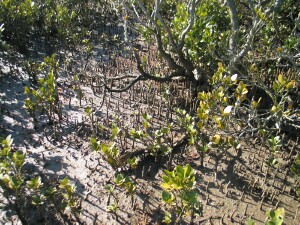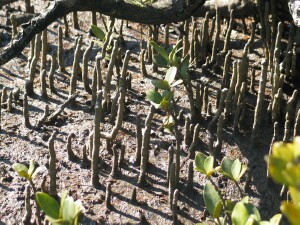White Mangrove
Back | Salinity Indicator Plants Home | Common name home | Scientific name home | Photo Gallery | Glossary
| White Mangrove photos | Family: Verbena (Verbenaceae) |
| Scientific Name: | Avicennia marina subsp. australasica | 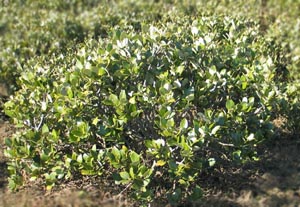 White Mangrove bush Photo: A J Brown | ||||||
Other Common Name: | Grey Mangrove | |||||||
Status: | Native of Western Australia, South Australia, Victoria, New South Wales, Queensland, New Guinea and New Zealand. | |||||||
Plant Description: | A small tree or shrub to 9 m tall with air-breathing roots (pnematophores) growing from a shallow root system. Branches, flower-heads and under-side of leaves are greyish or silver while the upper leaf surface is green. Leaves are 3.5-12 cm long and 1-4 mm wide on short stalks from 5-10 mm long. Flower-heads are at the end of branches or in the junction between stem and leaf. Flower stalks are angular and from 10-25 mm long. Flowers are white turning golden with age. Fruits are capsules 20-30 mm diameter, each with one seed which germinates before the fruit falls. | |||||||
Habitat: | Grows in saline mud of tidal estuaries and inlets along parts of the central and east coastline (e.g. Lake Connewarre, Swan Bay, Port Phillip Bay, Western Port Bay, Anderson’s Inlet, Shallow Inlet, Corner Inlet).
| |||||||
Comments: | The only Victorian species of about 30 Australian species. Mangrove forests provide important habitat as fish nurseries, bird nesting sites and intertidal zones for coastal animals such as crabs, shellfish and prawns. The wood of mangrove was used by indigenous people for making boomerangs, spears and digging sticks, while sap was used as medicine for treating headache, ulcers, stings and snake bite. Crushed leaves floated on water was used to stun fish. | |||||||
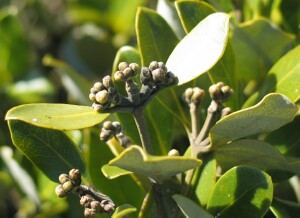 White Mangrove flower buds Photo: A J Brown | 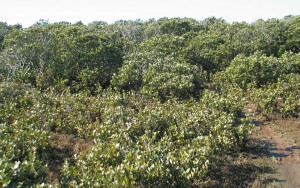 White Mangrove forest Photo: A J Brown |
|
|
|
|
 White Mangrove fruit Photo: A J Brown |

